Proud Member of

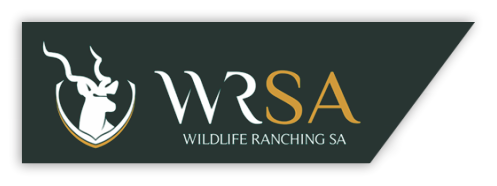

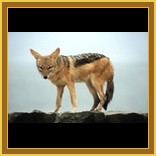 (Canis mesomelas)
(Canis mesomelas)Two sub species are notable. The Black-backed Jackal is most common and found throughout Southern Africa. The Side-stripped Jackal occurs mostly in the northern reaches of Namibia, Botswana, and parts of Zambia. We will concentrate here on the habits of the Black-backed jackal,
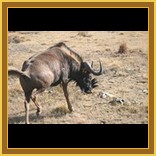 (Connochaetes Gnou)
(Connochaetes Gnou)At first glance, hunting Black Wildebeest may seem rather easy, as on the open plain where he is often found, he will be relatively easy to locate. However, closing the distance on him may be an entirely different matter; his excellent senses and herd instinct make hunting
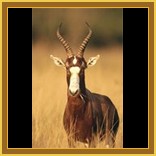 (Damaliscus dorcas phillipsi)
(Damaliscus dorcas phillipsi)The Blesbok lives on the open plains of the South African highveld. Primarily grazers, they form herds consisting of females (ewes) and juveniles, while the males (rams) tend to be solitary. The neck and top of the back is brown, darker on the flanks with a white belly. A small white blaze above the eyes and a larger blaze below is usually divided between the eyes.
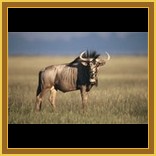 (Connochaetes taurinus)
(Connochaetes taurinus)Hunting Blue Wildebeest with Witkop Safaris or the brindled gnu as he is also known, can be most exciting. This large, bearded antelope native to the acacia savanna and short grass plains is often referred to as the “poor man’s” buffalo. His numbers have dwindled somewhat in many of his old habitats, but he is as plentiful as ever on the Serengeti ecosystem where his numbers may well exceed one million.
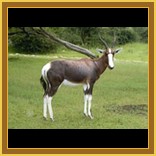 (Danaliscuc dorcas dorcus)
(Danaliscuc dorcas dorcus)The Bontebok is a closely related to the Blesbok. The two species can often be confused, however the Bontebok tends to be much more colorful with much more white evident on the face, rump and legs. The prominent white blaze on the face and forehead of the Bontebok tends to merge.
 (Equus burchelli)
(Equus burchelli)The Burchell’s Zebra is distinguished from the other zebra species by several pattern features. First and foremost are the shadow stripes, which occur within the broad white stripes found on the hindquarters; he lacks the grid-iron pattern and the dewlap, which is typical on the other species.
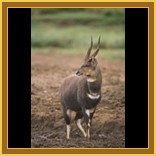 (Tragelaphus scriptus)
(Tragelaphus scriptus)The Bushbuck is the smallest member of the spiral horned antelope. He is of medium size, dark reddish-brown with white spots on the rump, against the legs, at the base of the neck, and just below the throat. Hunting Bushbuck with Witkop Safaris can be a real challenge as he is shy and extremely elusive.
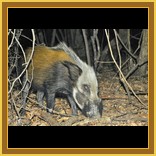 (Potamochoerus porcus)
(Potamochoerus porcus)The Bush Pig is the African equivalent of the European wild boar. He bears similarities to the feral hogs common in many areas of the US. While he tends to be somewhat smaller than both his European or North American counterpart, he shares the same nasty disposition and aggressive behavior common to most wild members of the swine family.
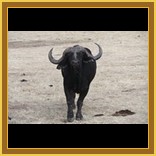 (Syncerus caffer)
(Syncerus caffer)The Cape Buffalo, or Southern Buffalo as he is also known, is considered by many to be the most dangerous of all of the Big Five. While he seems docile enough when viewed undisturbed in the herd, when agitated or wounded this bovine can be extremely aggressive, vindictive, and cunning.
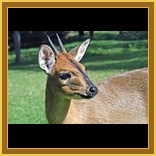 (Sylvicapra grimmia)
(Sylvicapra grimmia)The Grey Duiker is a medium-sized duiker, still much smaller that most of the other antelope species. You can think of him as modified for life in the savannah woodlands. His legs are longer and better developed, while his back is less rounded than the forest duikers.
 (Crocodylus niloticus)
(Crocodylus niloticus)The Nile Crocodile is truly one of Africa’s most unusual trophies. This prehistoric looking reptile, while somewhat shy, wary, and cautious, can be extremely dangerous if encountered by chance. The “Croc” is a long living, slow growing creature, a trophy sized crocodile may be well over 75 years of age.
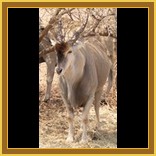 (Taurotragus oryx)
(Taurotragus oryx)The Cape Eland is Africa’s largest antelope. He can weigh-in at over 2000 pounds. The largest of the spiral horned antelope, this ox like bovid develops the thick neck, hump, and dewlap characteristic of the Brahma bull. Color is grayish-brown with older males developing a bluish-grey around the neck. Some specimens exhibit faint, vertical stripes down the flanks.
 (Loxodanta africana)
(Loxodanta africana)The African Elephant is the world’s largest land mammal. He stands more than eleven feet at the shoulder and can weigh-in at over seven tons. His dark grey skin provides excellent camouflage in the dense brush of the bushveld. He moves through the bush with amazing speed for his size and can be extremely quiet.
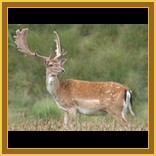 The Fallow Deer is a non-indigenous specie imported from Europe during the early colonization of South Africa. A ruminant mammal and exclusive grazer, the Fallow Deer adapts readily to most habitats. He can be found in the the wooded areas of the bushveld to the open plains and mountain ranges.
The Fallow Deer is a non-indigenous specie imported from Europe during the early colonization of South Africa. A ruminant mammal and exclusive grazer, the Fallow Deer adapts readily to most habitats. He can be found in the the wooded areas of the bushveld to the open plains and mountain ranges.
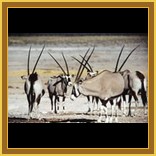 (Oryx gazella)
(Oryx gazella)The Giant Oryx or Gemsbok as he is more commonly called is a magnificent animal. He inhabits the open country and can survive in the harshest of conditions. A native of the Kalahari, he can go without surface water for months taking moisture from what he eats. A gregarious herd animal, he is primarily a grazer but will occasionally browse if necessary.
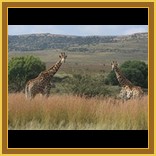 (Giraffa comelopardalis)
(Giraffa comelopardalis)The Giraffe is the largest ruminant and the tallest mammal on the planet. This tall “drink of water” can top out at nearly 18 feet in the largest of males. Horns are of solid bone and carried by both Cows and Bulls; they are skin-covered, tufted and thin on the female and thick and bald on top for the male.
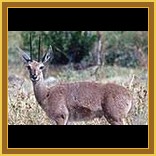 (Pelea capreolus)
(Pelea capreolus)The Rhebok is thought to originate from the early settlers seeing the likeness between this unusual antelope and the roebuck or European roe deer. The name evolved over time to its present spelling. The Grey Rhebok is a medium sized antelope, grey-brown in color with thick, wooly hair.
 (Hippopotamus amphibious)
(Hippopotamus amphibious)Some of Southern Africa’s professional hunter’s associations have added the Hippopotamus to their list of dangerous game, and rightfully so! The Hippo can be extremely aggressive when disturbed and accounts for more human deaths on the African Continent than all of the other members of the Big Five.
 (Aepyceros melampus)
(Aepyceros melampus)Hunting Impala with Witkop Safaris is on the agenda for just about every hunter who sets foot on the Dark Continent. The Rooibok or “red buck” as he is known in Afrikaans is the bread and butter antelope of Southern Africa.
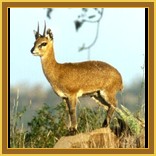 (Oreotragus oreotragus)
(Oreotragus oreotragus)Black speckles on a brown background can provide excellent camouflage when this mini antelope is on his rocky habitat. Distinguished from the other small antelope by these black speckles and the large black “tear marks” found in the inner corners of his eyes, the female of the species is slightly heavier than the male but lacks horns.
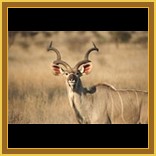 (Tragelaphus strepsiceros)
(Tragelaphus strepsiceros)Hunting Kudu with Witkop Safaris remains on the top of the list for just about every hunter who comes to Africa. He is probably second only to the Impala as Africa’s most sought after trophy. The Kudu is a big antelope, displaying stately bearing. He is strikingly beautiful with long spiral horns, which set him apart from all other of the antelope species.
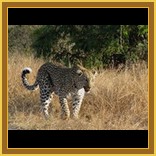 (Panthera pardus)
(Panthera pardus)The Leopard is the smallest of the Big Five, but don’t under-estimate this cat! He can be most dangerous when wounded and is probably the animal most likely to charge. This feline is a shy, solitary, nocturnal animal, widely distributed across the African Continent. The Leopard can live without water by extracting it from his prey however he will drink regularly if water is available.
 (Panthera leo)
(Panthera leo)The African Lion may not live up to his reputation as “King of the Jungle”, but he is without question the King of all African predators! While in many circles, the Buffalo is considered the most dangerous of African game; the Lion is probably the best known, most respected, and feared member of the Big Five.
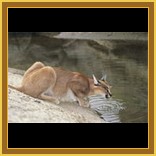 The Caracal or Rooikat as he is known in Afrikaans is a relatively small Lynx-like creature a bit like North America’s Bobcat. He is stockier than his close cousin the Serval and his fur varies from light red to a rather dark brick red.
The Caracal or Rooikat as he is known in Afrikaans is a relatively small Lynx-like creature a bit like North America’s Bobcat. He is stockier than his close cousin the Serval and his fur varies from light red to a rather dark brick red.
He is characterized by a rather short tail and prominent,
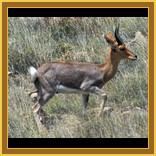 (Redunca fulvorufula)
(Redunca fulvorufula)
As his name implies, this medium sized antelope, is found in mountainous areas, on dry rocky slopes and hills where sufficient grass and shelter is readily available. The Mountain Reedbuck will usually avoid open areas and peaks, staying close to the rocks, trees, and scrub, which he uses for cover.
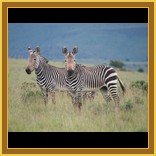 (Equus zebra hartmannae)
(Equus zebra hartmannae)If hunting mountain Zebra with Witkop Safaris is your goal, all that applies to the slightly larger Burchell’s variety applies. The Cape Mountain Zebra and Hartman’s Mountain Zebra are basically the same animal and differ for the most part only in where they are found.
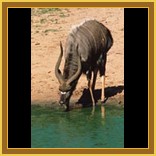 (Tragelaphus angasii)
(Tragelaphus angasii)This elegant and slender member of the spiral horned tribe is native to Zululand. His name translates in the Zulu language to “shifty one”, descriptive of his elusive nature. An interesting note here: the Nyala marks the dividing line between the large and smaller species of antelope.
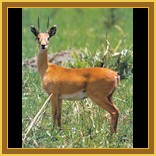 (Ourebia ourebi)
(Ourebia ourebi)The Oribi is a small antelope, very similar in appearance, but slightly larger that the Steenbok. He is a rusty-brown with a white throat and belly, having a few white spots next to the nostrils and above the eyes.The tail is black on top and white on the bottom distinguishing him from the Steenbok, which lacks the black on the tail.
 (Struthio camelus)
(Struthio camelus)The Ostrich is the planet’s largest living bird. He is flightless and characterized by soft, drooping feathers. Found widespread over much of southern Africa he has only two toes, a very long neck and very long legs. His neck and head are covered with fine bristles, while his legs are bare.
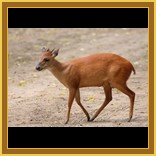 (Cephalophus natalensis)
(Cephalophus natalensis)The Red Duiker, is a bit smaller than the Common or Grey Duiker, but somewhat larger than the Blue Duiker. The most distinguishing feature is his chestnut-red coloring. This mini-antelope is characterized by the crest of red and black hair on the top of the head, sometimes almost appearing to be a third horn.
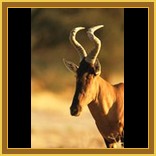 (Alcelaphus buselaphus)
(Alcelaphus buselaphus)Sometimes nicknamed the “Harley Davidson” of the antelope tribe, because of the configuration of his horns, this “beest” is truly a strange looking creature. The elongated appearance of the face is exaggerated by the smooth unringed section of the horns, which continues on the same line as the face.
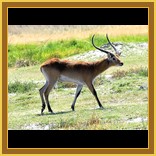 (Kobus leche)
(Kobus leche)
The Red Lechwe is a medium sized antelope exhibiting characteristic dark markings on the forelegs. His body slants forward as his front shoulders are lower than his croup. Not to be confused with the Puku, which is smaller, lacking the markings on the forelegs and more golden in color, this bright reddish specimen will always be found near water.
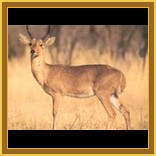 (Redunca arundinum)
(Redunca arundinum)The Common or Southern Reedbuck is a medium sized antelope generally found near water and especially on the floodplain. He is distinguished by a long neck and body, sturdy legs, and powerful hindquarters.
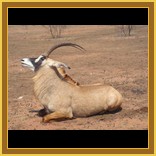 (Hippotragus equinus)
(Hippotragus equinus)This fairly large antelope is indigenous to the more northern reaches of Southern Africa however, game ranching has made him available in many places where he was not found. His name “roan” refers to his color, which shows a strawberry tint when the light is right.
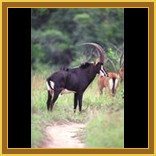 (Hippotragus niger)
(Hippotragus niger)The Sable Antelope is another of the Hippotragus (horse) tribe antelope. As in the case of the Roan, his Afrikaans name (Swartwitpens) meaning black, white belly is rather undignified when applied to this most regal and strikingly beautiful animal.
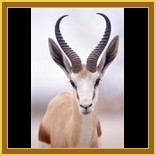 (Antidorcas marsupialis)
(Antidorcas marsupialis)The Springbok is probably the only true gazelle found in the sub region of Southern Africa. Some maintain that the Impala is also a gazelle but most put him in a clan all by himself. These beautiful little antelope inhabit the more western reaches of Southern Africa.
 (Raphicerus campestris)
(Raphicerus campestris)I know it looks like “steenbok” (long E) but it is normally pronounced “steinbok” (long I). This can lead to a bit of confusion, at least for some Europeans, as the name “steinbok” is the German name for the ibex. The Steenbok is the largest of the mini antelope associated with the “Little Five”.
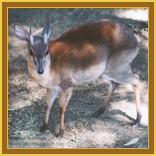 (Neotragus moschatus)
(Neotragus moschatus)Another of the dwarf antelope, the Suni inhabits the coastal areas of Natal Province in South Africa, most of Mozambique, and further northward into the Zambezi Valley. Only the males carry horns, while the female of the specie tends to be just a bit heavier.
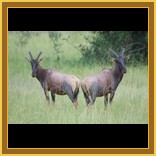
It is only fitting that this very strange looking antelope be saddled with such a strange sounding name. The name is derived from the Tswana name, "tshesebe". The Tsessebe is larger and somewhat different in appearance than the other two animals
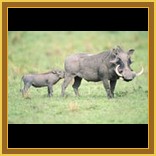 (Phacochoerus aethopicus)
(Phacochoerus aethopicus)The Warthog is a rather common member of the wild pig clan. A distant cousin of the European boar, he is a popular trophy with many safari clients. He favors open ground, grasslands, water holes and pans and will often be seen in the open woodlands. He especially likes to graze on the newly sprouted grass of a burned out area.
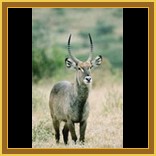 (Kobus ellipsiprymnus)
(Kobus ellipsiprymnus)
The Waterbuck is one of the larger antelope, and just as his name implies, he is never found very far from water. Normally found in small herds of about 12 animals, this rather large antelope is for the most part a grazer. Similar in appearance to a donkey, only the bulls carry horns;
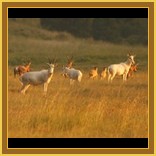 (Damaliscus pyganus)
(Damaliscus pyganus)All that has been said regarding hunting the common Blesbok and the Bontebok, can be applied when hunting the White Blesbok. A mutation in color, the White Blesbok is not an albino, but rather merely a variation in color. Find the “White” mixed in with the herd of Common Blesbok.
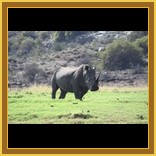
The White Rhino, through much effort by hunters as well as conservationists has increased in numbers sufficiently to once again be hunted in South Africa. The Black Rhino (Diceros bicomis) has not made such a successful comeback and is still highly protected.
![]()
We have 386 guests and no members online